How Generative AI is Revolutionising Search (And Your SEO Strategy)
By Andrew Tomison:
AI Search Strategist & Researcher
- How Generative AI is Revolutionising Search (And Your SEO Strategy)
- 1. Introduction
- 2. The Evolution of Search: From Keywords to Conversations
- 3. Inside AI Search: How Answer Engines Work
- 4. Why Conventional SEO Fails in the AI Era
- 5. The New Strategic Framework for AI Search
- Becoming a Primary Source for AI
- How AI Constructs Meaning & Attributes Authority to Content
- Zero-Click Search: Replacing Clicks & Redefining Visibility
- Generative Engine Optimisation (GEO): Redefining Search Strategy
- Dual-Intelligence Architecture (DIA): Bridging Machine Logic & Human Engagement
- Navigating the AI Search Revolution: Your Path Forward
- 6. AI Search: Frequently Asked Questions
1. Introduction
How AI Is Reshaping Your Digital Content Right Now
Google’s launch of AI Mode in May marked a watershed moment in the evolution of search. For years, search engines operated as directories of links, rewarding keyword tactics and backlinks. Now, with AI Mode, Google Search is shifting towards a persistent, conversational interface – where generative AI delivers direct answers, recommendations, and actions, all within the search experience.
This isn’t just a new feature; it’s the culmination of a much broader shift underway. For decades, search was defined by the ‘ten blue links’ – a static list of results ranked by keywords and backlinks. Now, AI-powered engines like Google Gemini, Perplexity, and ChatGPT are redefining how information is found, cited, and trusted online. Instead of ranking for clicks, brands must now become the trusted sources that AI systems reference, cite, and weave directly into their answers.
For businesses and publishers, the implications are profound. Success in this new landscape means moving beyond traditional SEO tactics and embracing strategies that establish your authority, expertise, and relevance within the AI-driven knowledge ecosystem.
This guide unpacks that new reality – and what it means for your content, SEO, and digital presence in the age of AI search.
Human Communication, Mediated by Machines
As generative AI reshapes how people discover and interact with content, machines are increasingly becoming the gatekeepers of human connection – rating, aggregating, re-versioning, and recommending information online.
The paradox: While generative AI tools have made it easier than ever to produce content at scale, AI-powered search engines and answer engines now control both the selection and presentation of content that reaches human audiences
Success demands dual optimisation: creating content machines can discover, comprehend, and prioritise, while simultaneously differentiating through human originality and insight.
Generative AI marks a turning point in how we communicate. Earlier technologies shifted how we shared and discovered information. Now, AI actively mediates these communications, deciding what information reaches audiences and how it’s presented.
Inflection Points in Mass Communication: From Cave Walls to AI

About the Series: Mastering AI Search with GEO
This guide is part of our series: Mastering AI Search: Your Guide to Generative Engine Optimisation (GEO), breaking down the shifts you need to understand – and act on – to succeed in the AI search era.
To stay competitive, the series will explore five essential strategies:
- How Generative AI is Revolutionising Search (and Your SEO Strategy) – Shifting from keywords to conversations
- Decoding Generative Engine Optimisation (GEO) – a new framework purpose-built for visibility in AI-powered search.
- Building content AI trusts – establishing authority through E-E-A-T principles.
- Earning citations through digital PR – positioning your content as a trusted source for AI-generated answers.
- Designing AI-first websites and content structured systems – structuring your site for machine comprehension and semantic clarity.
We’ll start with the foundation: how search itself has evolved from keywords to conversations – revolutionising search (and your SEO strategy)
The 5 Pillars of AI Search Visibility
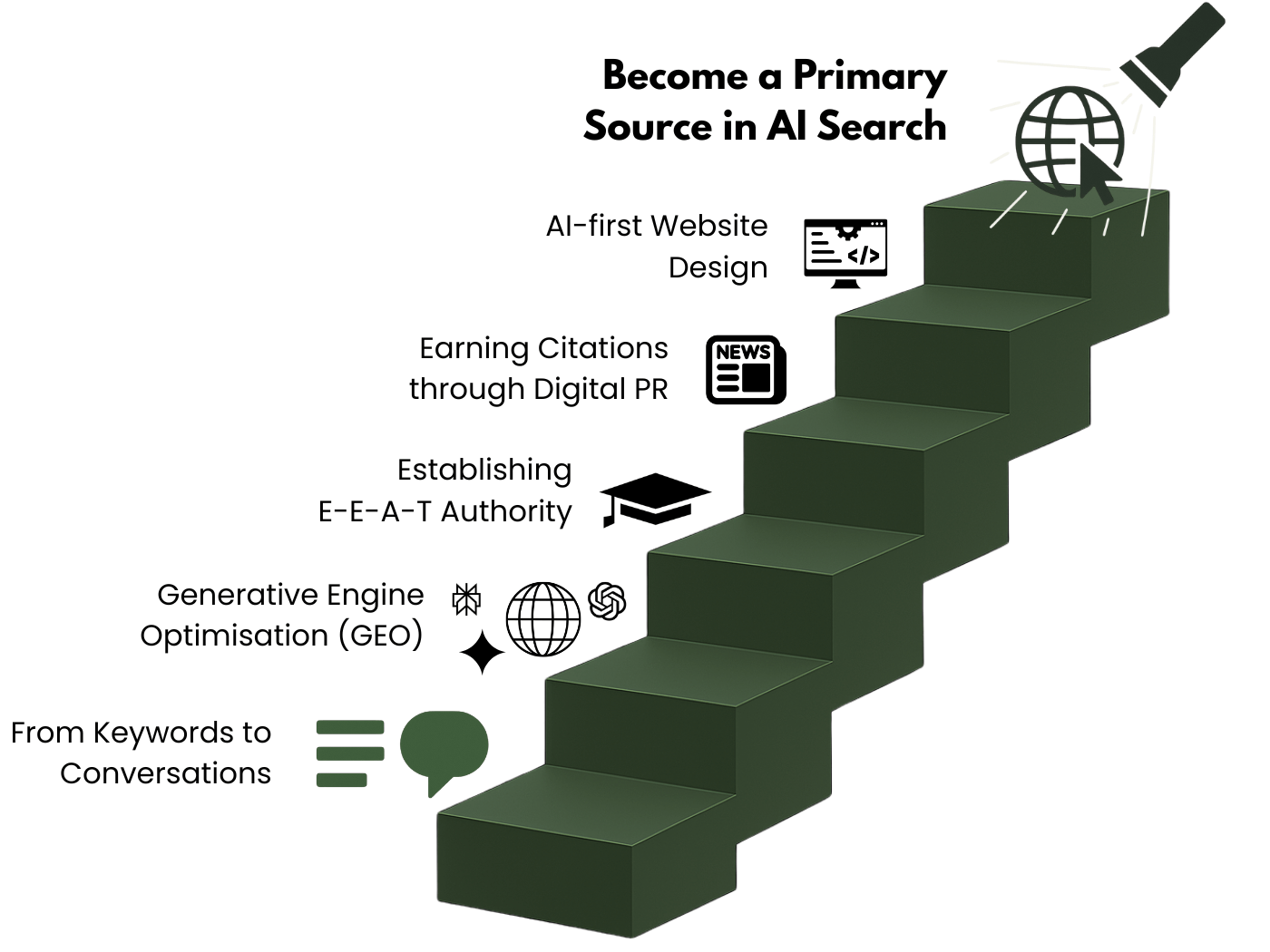
2. The Evolution of Search: From Keywords to Conversations
Google’s Mission & the Evolution of Search
Search engines exist to connect users with relevant, useful information tailored to their needs – a deceptively simple goal that has driven decades of innovation.
Google’s mission encapsulates this: “To organise the world’s information and make it universally accessible and useful.” This guiding principle has shaped the major developments in search technology.
In the early 2000s, platforms like Google, AltaVista, and Yahoo relied on exact-match principles to interpret user intent. For example, a query like “best Italian restaurants Melbourne CBD” would return a straightforward list of dining options with reviews and opening hours.
But these systems often faltered with more conversational queries. A search for “restaurants with views of the Yarra that won’t break the bank” might yield a disjointed mix of luxury riverside venues, budget accommodations, and even Yarra Valley wineries – none of which truly address the need for affordable riverside dining in Melbourne’s CBD.
This mismatch highlighted a critical gap between human communication and machine interpretation.
Early Search Engines: Limits & Loopholes
This disconnect between how humans communicate and how search engines interpreted queries revealed significant limitations in early search technology. It also gave rise to an entire industry: Search Engine Optimisation (SEO).
SEO practitioners developed techniques to bridge this gap by presenting content in ways search engines could understand. While many focused on delivering genuine user value, others exploited algorithmic loopholes – creating keyword-stuffed pages with little substance.
By 2010, SEO had evolved into a mainstream marketing discipline, but manipulative tactics often undermined its credibility. Neither poor search results nor exploitative practices served Google’s mission of delivering relevant information to users.
To combat these issues, Google implemented a steady stream of algorithm updates aimed at improving results and eliminating manipulative tactics. From Panda to RankBrain, these updates refined how search engines understood user intent and prioritised quality content.
Today, users no longer have to ‘speak search engine’ – machines are learning to speak human.
The Evolution of Search Technology
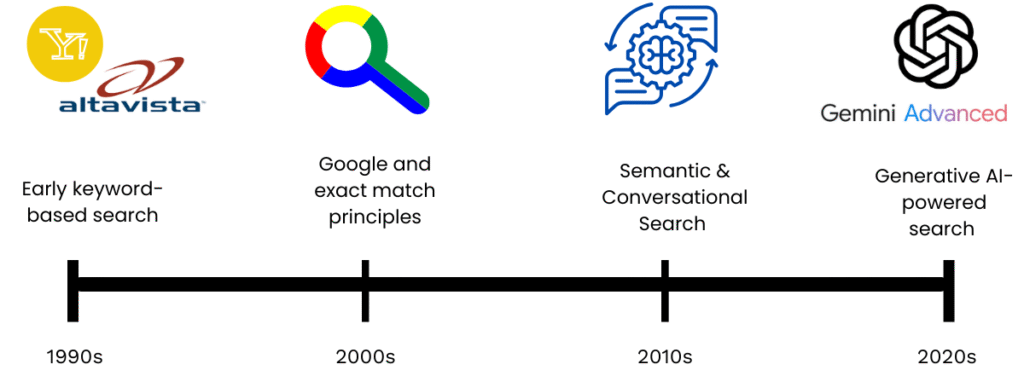
AI Search: The Conversational Revolution
Generative AI represents a paradigm shift in search technology. By 2025, systems like Google Gemini and ChatGPT have developed advanced capabilities to comprehend natural human communication – ushering in an era where searches feel more like conversations than mechanical queries.
Users can now express complex needs intuitively without fragmenting their thoughts into awkward keyword combinations. This conversational approach mirrors natural human dialogue, making information discovery faster and more precise.
The rise of voice search highlights the shift clearly:
- According to Google, over 20% of all searches are conducted via voice. And more than half of mobile users regularly rely on voice assistants for queries.
These advancements are reshaping not just how we search but also how businesses optimise their content for visibility within these conversational systems.
Why GEO is Replacing Legacy SEO
A Media Collateral and State of Digital Publishing (SODP) industry study reveals that 76% believe generative AI will fundamentally disrupt SEO – either rendering it obsolete or transforming it entirely.
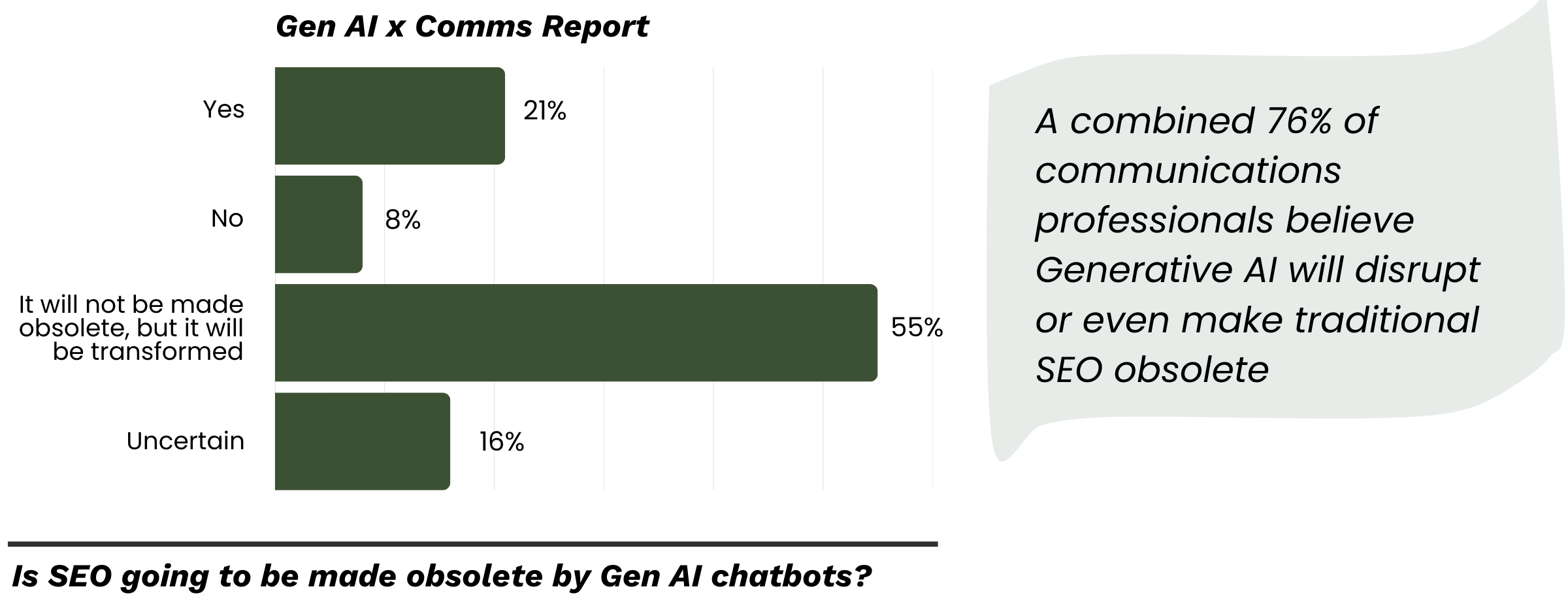
This disruption shows why businesses must move beyond traditional tactics and adopt Generative Engine Optimisation (GEO). First proposed by Princeton researchers in 2024 the model has since evolved into a practical framework for optimising content in AI-driven search ecosystems powered by LLMs like ChatGPT, Gemini, Claude, and DeepSeek.
In this series, we’ll dive deeper into mastering Generative Engine Optimisation (GEO) as part of adapting to AI-driven search ecosystems. But first, to understand why GEO is essential, let’s first explore how modern AI answer engines operate – and how they differ fundamentally from traditional search systems.
3. Inside AI Search: How Answer Engines Work
How Google Gemini & ChatGPT Generate Answers
LLMs (large language models) like ChatGPT and Google Gemini act as direct answer engines, marking a fundamental departure from traditional search engines. While conventional search engines rely on matching keywords to indexed web pages, LLMs generate responses by drawing on patterns learned from vast datasets during training.
Users now have access to a growing number of LLMs driving information discovery, including emerging platforms like Grok (known for its advanced reasoning capabilities), Claude (recognised for its human-like creativity) and DeepSeek (valued for its logical precision).
Inside the AI Mind’s Eye: How Leading LLMs Explain their Answers

Traditional search engines functioned like massive phone directories. For example, a query like “best Italian restaurants in Melbourne” would return a list of indexed results, leaving users to sift through pages and contact individual businesses for details.
LLMs operate more like having a conversation with a knowledgeable concierge. When asked about Melbourne’s Italian dining scene, they synthesise information to provide personalised recommendations – highlighting popular local favourites, authentic cuisine options, and even wine pairings for an enhanced dining experience.
Traditional Search Engines vS. LLM Answer Engines
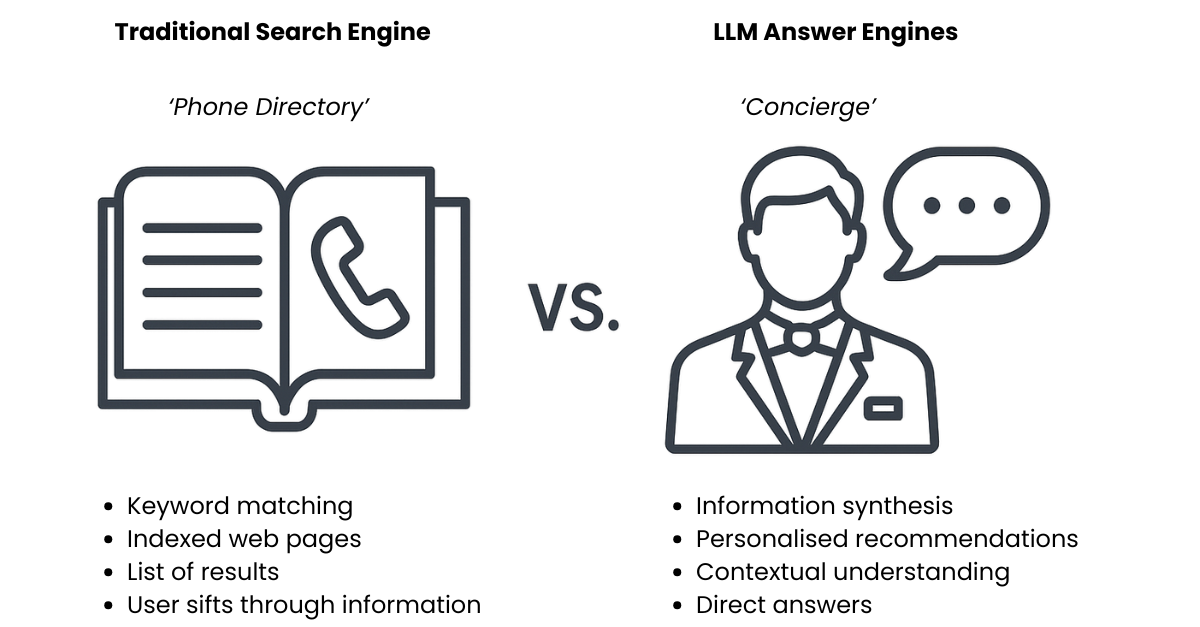
LLMs achieve this through transformer neural network architecture, which enables them to process text bidirectionally. They analyse words in relation to their surrounding context, mapping relationships between words and ideas mathematically. This positions semantically similar concepts closer together and supports nuanced understanding.
Despite these capabilities, foundational LLMs face limitations such as knowledge cutoffs – specific dates beyond which they lack information – and occasional hallucinations when generating responses outside their training data.
LLM Knowledge Gaps & Hallucinations
While foundational LLMs excel at synthesising information, they operate with significant constraints. One of which is knowledge cutoffs – a fixed date beyond which they cannot incorporate new information. This cutoff date is not always clearly communicated for LLMs like ChatGPT, often leading to intense speculation within developer communities.
This creates a fundamental challenge for real time search applications. Base LLM chats – without live retrieval – can hallucinate: confidently stating incorrect information to fill gaps. Hallucinations are not limited to outdated knowledge; they can also occur due to gaps in training data or overgeneralisation.
For example:
- A query about niche scientific research may lead to fabricated citations or studies.
- Overgeneralisation might result in responses that misinterpret specific cultural or regional nuances.
These limitations reveal why foundational models alone can’t meet the demands of dynamic, real-time search – initiating the need for AI answer engines that integrate live data retrieval.
Google AI Mode: Redefining Real-time Search
To overcome the limits of static LLMs, platforms like Perplexity, ChatGPT Search, Google’s AI Overviews, and Microsoft Copilot now retrieve live information from the web – a process known as Retrieval-Augmented Generation (RAG). When users ask about current events or niche topics, these engines scan trusted sources in real time and generate cited summaries.
Launched at Google I/O 2025, Google’s AI Mode is now available to Google Search users in the U.S. and will be rolled out in Australia soon. This advanced mode – powered by Gemini 2.5 – combines real-time retrieval with advanced reasoning, agentic actions, and multimodal input to deliver a fundamentally new search experience.
AI Mode stands apart by breaking down complex queries into a network of sub-questions – a process Google calls ‘query fan-out’. It runs these searches in parallel, often using ‘deep research’ capabilities for thorough exploration, then synthesises a single, comprehensive, and richly cited response – all within Google Search.
For brands, this leap means the competition is no longer for a ranked spot, but for inclusion as trusted material within the AI’s answer.
E-E-A-T—Experience, Expertise, Authoritativeness, and Trustworthiness—has never been more important. Content that demonstrates genuine authority and verifiable value is prioritised for inclusion in AI-generated responses, prompting a fundamental re-evaluation of traditional SEO strategies.
Agentic & Multimodal Capabilities
AI Mode enhances user interaction. Users can now complete bookings, make purchases, and interact using text, images, and soon video, all within the interface.
For brands, structured data, real-time inventory, and high-quality multimodal content are now essential for being surfaced and actioned by Google’s AI.
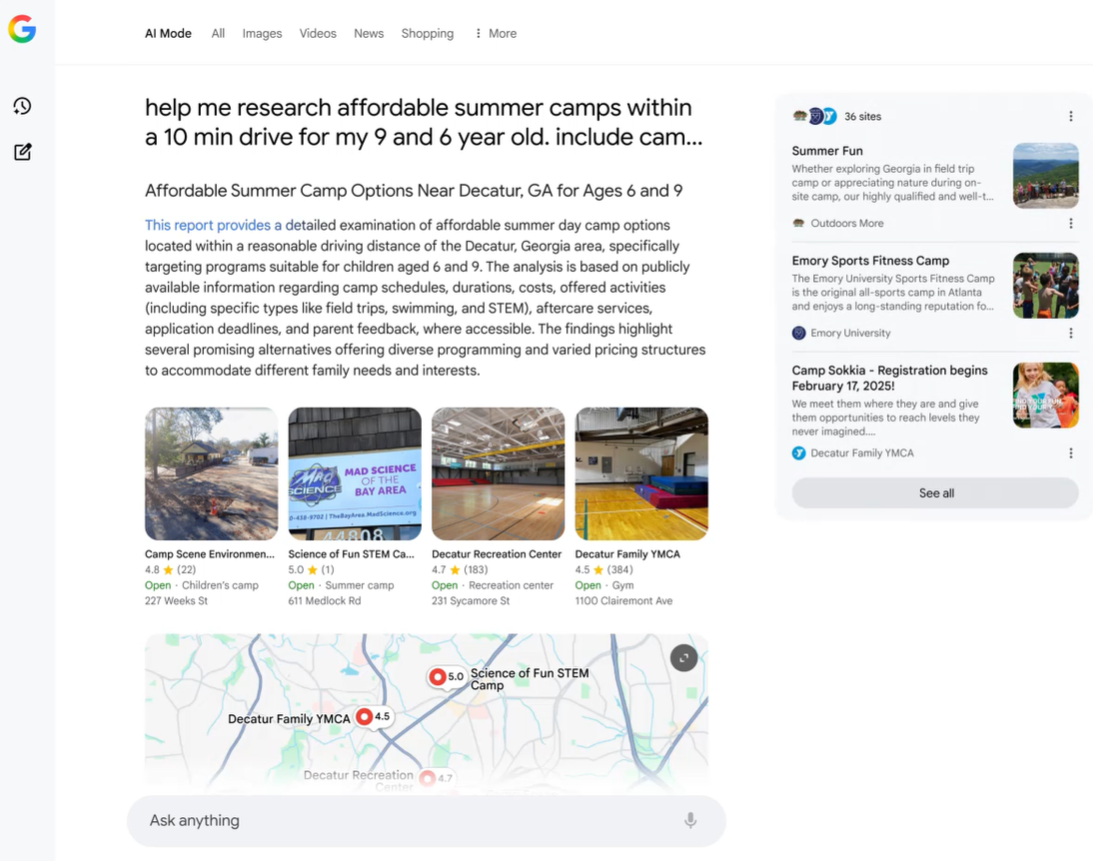
Citations vs Mentions
Linked citations act as the backbone of trust, providing direct source links that validate AI-generated responses. Whether surfaced as inline references, footnotes, or clickable previews, they offer users a quick path to verify information and assess its credibility.
Non-linked mentions, while not providing direct clickable traffic, are gaining significant influence as AI systems improve contextual understanding. These references still boost brand recognition and authority – reinforcing your presence in AI-generated answers and expanding visibility even without a direct click-through.
Attributions in AI Search: Citations & Mentions
| Type | Linking | Characteristics | |
| Inline Citations | Hyperlinked | Direct source links embedded in the AI-generated sentence. | 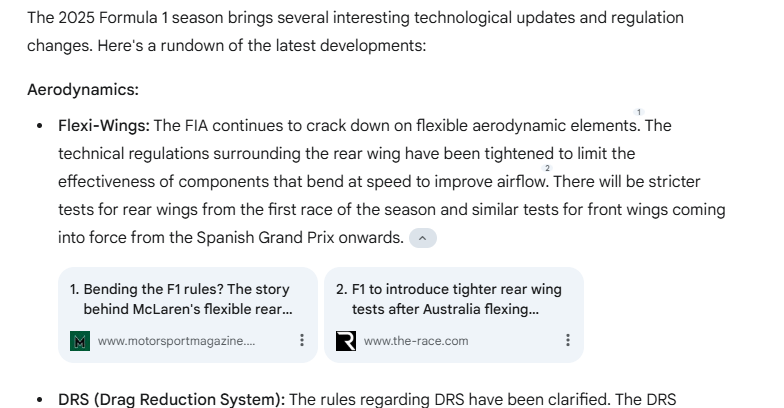 |
| Plain Mentions | Unlinked | Acknowledgements of entities, brands, or concepts without hyperlinks. |  |
| Source Lists | Hyperlinked | List of related sources provided outside the main response text. | 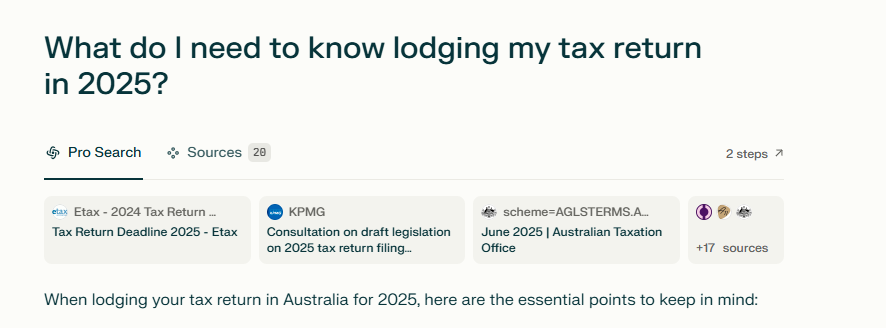 |
| Knowledge Panel References | Hyperlinked | Displayed in side panels or boxes, often referencing known entities. | 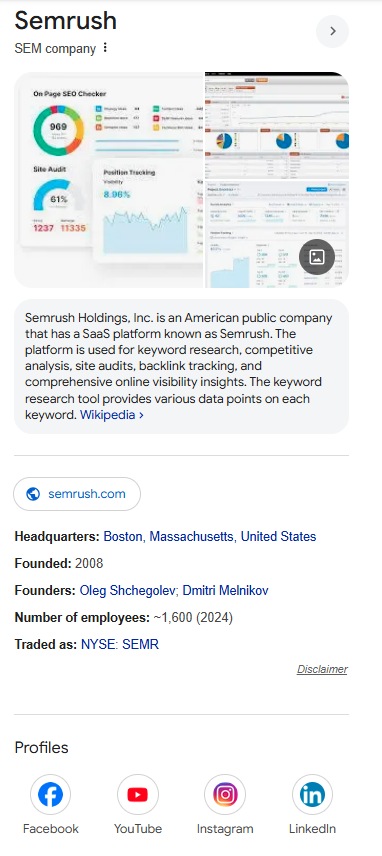 |
| Contextual Pop-Up Links | Hyperlinked | Interactive elements that dispInteractive source previews shown on hover or tap. | 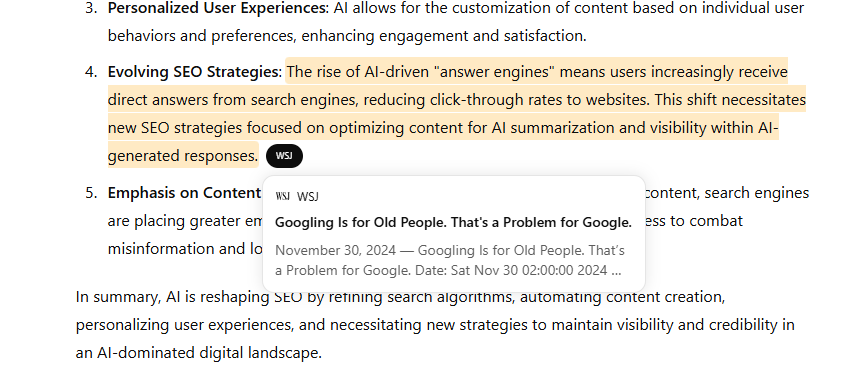 |
Citations and mentions represent the next frontier of search visibility, expanding what it means to be discoverable.
Rather than merely ranking on a search engine results page (SERP), brands are now surfaced directly within AI-generated responses – cited, referenced, and woven into the fabric of conversational search.
This marks a shift in visibility itself: from static listings to dynamic, human-like discussion.
As AI search continues to evolve, the ability to earn citations and mentions across platforms and content formats will define digital authority and exposure.
4. Why Conventional SEO Fails in the AI Era
From Keyword Stuffing to Semantic Understanding
AI search is up-ending how content is evaluated, making many traditional SEO tactics increasingly ineffective.
HubSpot, a leader in SEO and inbound marketing, has seen its organic traffic drop dramatically. This has been blamed on HubSpot publishing content outside their area of expertise, which lacked depth and topical authority. What Google might call “SEO-first content”, which was called out in its Helpful Content Update (2023).
HubSpot: A Penalty for Shallow Authority
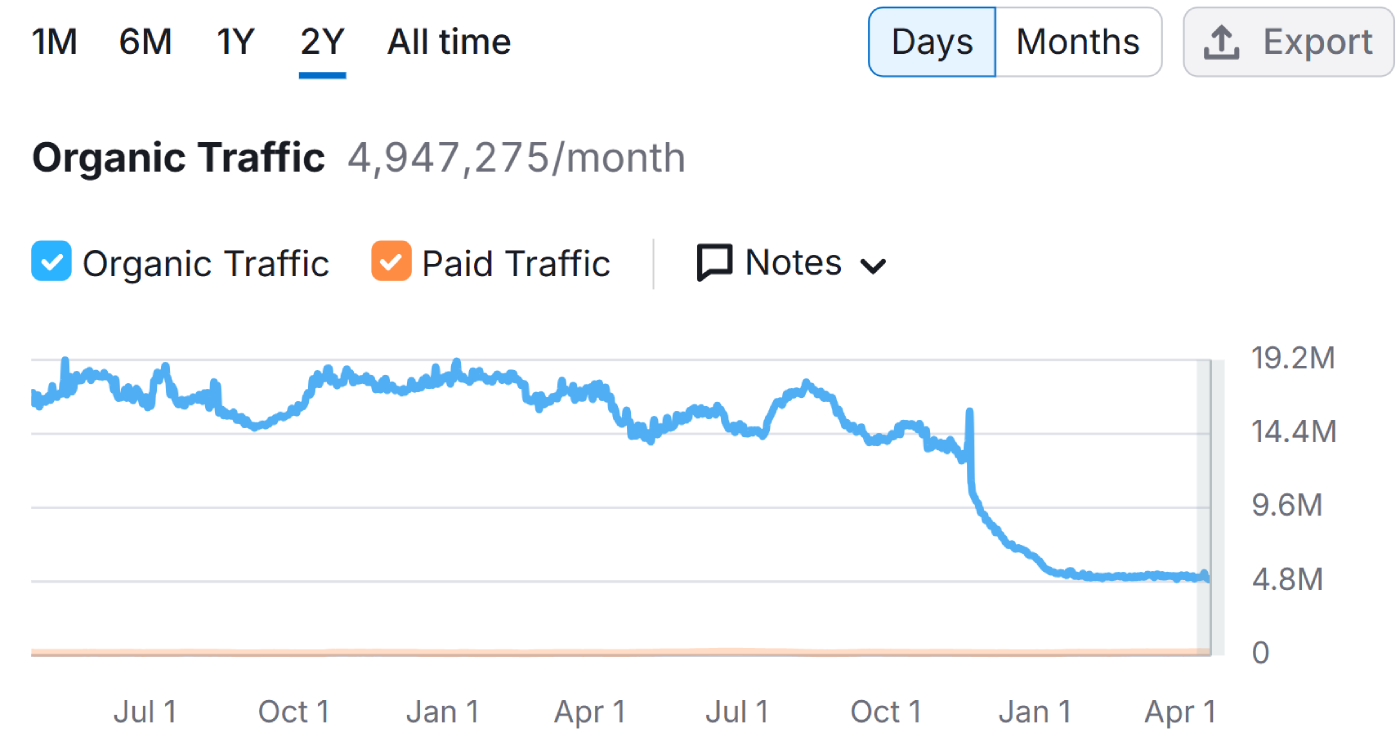
Gamiing content to succeed for search engines, rather than serve users been a recurring tactic throughout the history of SEO — particularly when it comes to keywords.
Keywords have historically served as search engines’ primary method for connecting users with relevant content – a proxy for what people were actually seeking.
Success in these early days of search optimisation was often measured by how effectively one could incorporate target phrases into web pages, rather than the actual value delivered to users.
The notorious ‘keyword stuffing’ era emerged from these mechanical SEO tactics, with some websites using manipulative tactics to game early algorithms.
This would see unnaturally repeating phrases dozens of times on a single page, and even hiding text in the same colour as the background – in pursuit of higher rankings.
Keyword Stuffing for Rankings, Not Readers
We are the best digital marketing agency in Melbourne. For the best digital marketing agency Melbourne services, look no further than us. Our best digital marketing agency Melbourne team provides exceptional best digital marketing agency Melbourne solutions. Searching for the best digital marketing agency Melbourne? We are your best digital marketing agency Melbourne in Melbourne. Contact the best digital marketing agency Melbourne today!
Reconstructed example of keyword stuffing, optimised for bots, not humans.
Google’s mission to “organise the world’s information” was directly undermined by these tactics, which obscured truly valuable resources beneath layers of artificially optimised pages.”
Google’s Algorithms are Now Penalising SEO-First Content – & Rewarding Real Authority
Google has sidelined keyword-first SEO through six core algorithm updates. Each, pushing search closer to semantic understanding and genuine content quality.
- Panda (2011) – Targeted low-quality content farms, prioritising substantive, user-focused content over keyword-optimised sites. This update marked Google’s first major step toward evaluating content quality rather than just keyword relevance.
- Penguin (2012) – Penalised aggressive keyword manipulation tactics and artificial link schemes, signalling Google’s commitment to reducing mechanical optimisation approaches that undermined search quality.
- Hummingbird (2013) – Introduced sophisticated natural language processing capabilities that could interpret intent beyond exact matches, marking the beginning of semantic search and laying groundwork for today’s AI search capabilities. This update represented Google’s early integration of AI-powered language understanding.
- RankBrain (2015) – Google’s first major implementation of machine learning in search, enabling understanding of context and relationships between concepts even when queries used unfamiliar terminology. This AI system helped Google interpret never-before-seen searches by connecting them to similar queries.
- BERT (2019) – A quantum leap in linguistic understanding that allowed Google to grasp nuanced meaning based on surrounding context, transforming search precision and bringing traditional SEO principles closer to natural language understanding. This neural network-based AI technique revolutionised how Google processed natural language.
- Helpful Content Update (2023) – Specifically targets content created primarily for search engines rather than users, rewarding content that demonstrates E-E-A-T components while penalising content created solely to attract search traffic without delivering substantive value. This update leverages advanced AI to evaluate content quality at scale.
Why Reverse-Engineered Keyword Optimisation Fails in AI Search
The fundamental flaw of traditional keyword optimisation is its reverse-engineered nature – beginning with search engine signals, rather than authentic user value. AI-driven search explicitly prioritises content built around genuine expertise, comprehensive coverage, and meaningful user insights, rendering keyword-first strategies increasingly ineffective and potentially harmful.
Think of keywords as individual words in a new language. They hold meaning, but true fluency emerges only when those words come together in phrases, sentences, and coherent conversations.
AI systems like ChatGPT or Google Gemini interpret entire queries, recognising nuances and underlying intent – much like fluent conversation.
In contrast, traditional, keyword-first strategies are akin to mastering a language by memorising long lists of disconnected words, without learning the grammar or context.
Modern AI-powered search prioritises content that shows genuine expertise, topical fluency, and comprehensive coverage. Keyword-centric content no longer meets AI’s expectation for meaningful, authoritative, and contextually rich information – making traditional SEO methods not only ineffective, but often damaging to visibility.
Keyword research still has value for understanding how your market speaks and what language your audience uses. But in the AI era, it should inform, not dictate your content structure or strategy.
Why do Keyword-Centric SEO Tactics Persist Despite Google’s Advances?
Despite their declining effectiveness, keyword-centric SEO tactics persist – a reflection of industry inertia and the limitations of traditional SEO tools.
Most keyword research tools still emphasise search volume and competition based on exact matches, offering concrete and reportable, but often flawed metrics. They fail to capture the semantic relationships and topical clusters that AI-powered search engines now prioritise. This reinforces outdated strategies, presenting SEO as a keyword acquisition exercise rather than a method for building topical authority.
The result is a growing gap between how AI search algorithms evaluate content and how many marketers optimise and measure their output. This gap offers a clear advantage to those who embrace intent-driven, sophisticated search strategies.
Keyword Tools: Concrete Metrics, Contextual Blind Spots
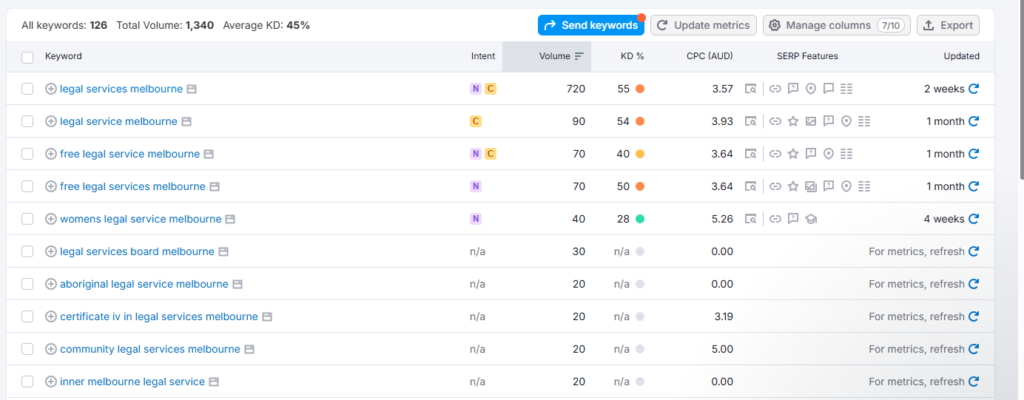
From Keyword Competition to Knowledge Ecosystems: How AI Evaluates Content
AI search has moved from ranking keywords to evaluating knowledge ecosystems – rewarding contextual depth over isolated phrases.
As a result, strategies that target a unique keyword per page – treating content as isolated pieces – are increasingly limited. AI-powered search now prioritises topical authority and semantic coherence across entire sites and the wider digital landscape.
Keywords still matter, but mainly as signals of user intent, not as standalone targets.
Issues like keyword cannibalisation – once seen as a problem – are now more nuanced. Rather than consolidating similar pages, AI recognises complementary content clusters that collectively signal expertise and comprehensive coverage.
Conversational and long-tail keywords are especially valuable, capturing nuanced user intent and reflecting natural language queries.
For example, a financial services firm might address:
- “Can I retire comfortably at 60 with a medical career?”
- “How can doctors best prepare financially to retire at 60?”
- “Is retiring at 60 financially viable for healthcare professionals with private practices?”
While these queries seem similar, each addresses a distinct nuance. AI recognises and rewards content that answers these variations, whether in a single guide or across interconnected resources.
The goal is no longer to optimise individual pages for isolated keywords, but to build comprehensive, interconnected content networks that demonstrate depth, breadth, and authority. AI search systems now easily spot shallow, keyword-driven content and instead reward authentic expertise and meaningful insight.
Brands that embrace this knowledge ecosystem approach will gain a decisive advantage as AI continues to reshape the search landscape.
When Backlinks Lose their Power
Backlinks once reigned supreme in SEO, thanks to Google’s PageRank, which treated links as digital votes of confidence. The system, articulated in the academic paper, ‘The Anatomy of a Large-Scale Hypertextual Web Search Engine revolutionised online authority – allowing search engines to assess not just what you said about yourself, but what others said about you.
The Commercialisation of Backlinking
However, the commercialisation of link building led to widespread manipulation – link farms, paid schemes, and reciprocal arrangements. Google’s Penguin update and subsequent refinements cracked down on these tactics, prioritising link quality, relevance, and source authority.
When Artificial Link Building Backfires: The Expedia Warning
The infamous Expedia penalty in 2013/14 saw the travel giant lose 25% of its search visibility and its stock price fall. It sent a clear message: artificial link building would not be tolerated, even for major brands.
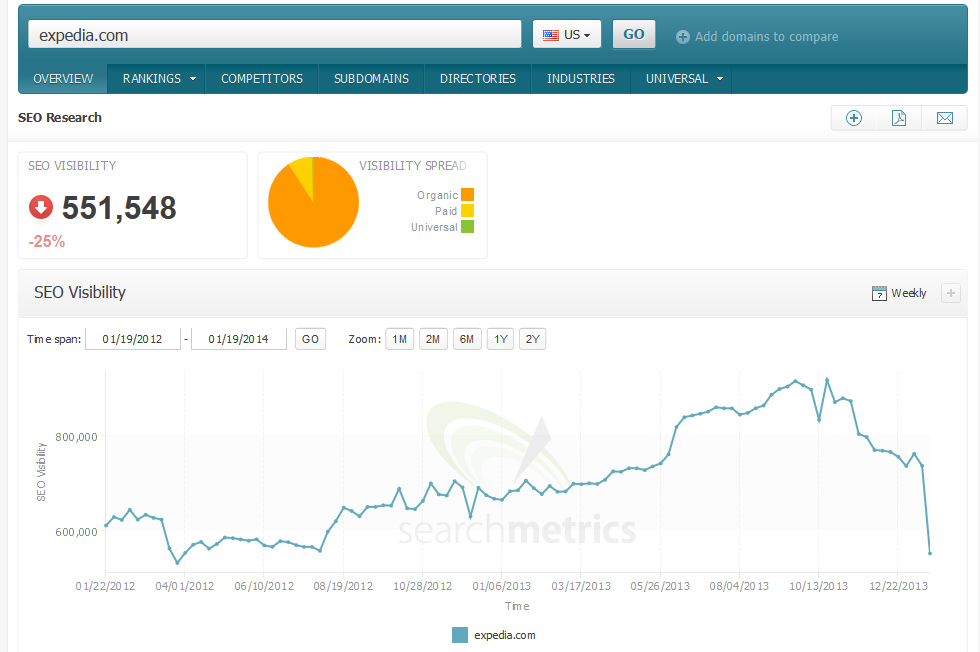
Despite these changes, many still blindly chase bulk backlinksy, often neglecting the real user value and endorsement that should drive strategy.
In today’s AI search landscape, backlinks remain important — but their role is shifting. Authority is no longer simply passed from one URL to another. Instead, AI systems evaluate trustworthiness through semantic relationships, entity recognition, and content corroboration.
5. The New Strategic Framework for AI Search
As AI-driven search engines transform how information is discovered, businesses must rethink SEO strategies to remain visible and authoritative in a rapidly evolving landscape.
Success now demands moving beyond static, keyword-focused tactics. AI search optimisation requires a holistic, dynamic approach – prioritising contextual relevance, entity relationships, and trust signals over isolated or mechanical methods.
This section unpacks the fundamental changes in search algorithms and outlines the key strategies businesses need to thrive in the AI search era.
Becoming a Primary Source for AI
From Words to Concepts: How Entities Underpin the AI Search Landscape
The next evolution in search isn’t about tactical adjustments, it’s about realigning with search engines’ foundational mission – connecting users with genuinely useful, relevant content. AI has transformed how effectively search engines can fulfill this purpose, moving well beyond the simplistic proxies of earlier eras.
Traditional search engines relied on pattern matching, indexing words and returning results based on exact keyword matches. In contrast, AI search engines identify and understand entities such as people, places, concepts, and things, as well as the complex relationships between them. This evolution, described by search expert Dixon Jones as the shift from “strings to things,” marks a fundamental transformation in how search engines interpret and evaluate content. For businesses, this means that success now depends on being recognised as a trusted entity within these knowledge networks
An entity, as defined by Google, is “a distinct, singular, and well-defined thing or concept that search engines can recognise and understand, such as people, places, organisations, events, or even abstract concepts.”
An entity-based approach shifts how AI search engines interpret content. Instead of just identifying keywords, they recognise and understand these entities and their connections, inferring relationships between topics, even when not explicitly stated in the text.
How AI Search Understands Entities: ‘Melbourne Coffee’ as a Connected Knowledge Ecosystem
For Australian businesses, this shift has major implications. Take a Melbourne café publishing content on single-origin brewing methods. Instead of just ranking for keywords like ‘best coffee in Melbourne’, AI places the café within a broader knowledge graph, linking it to specialty coffee, sustainable sourcing, and Melbourne’s café culture.
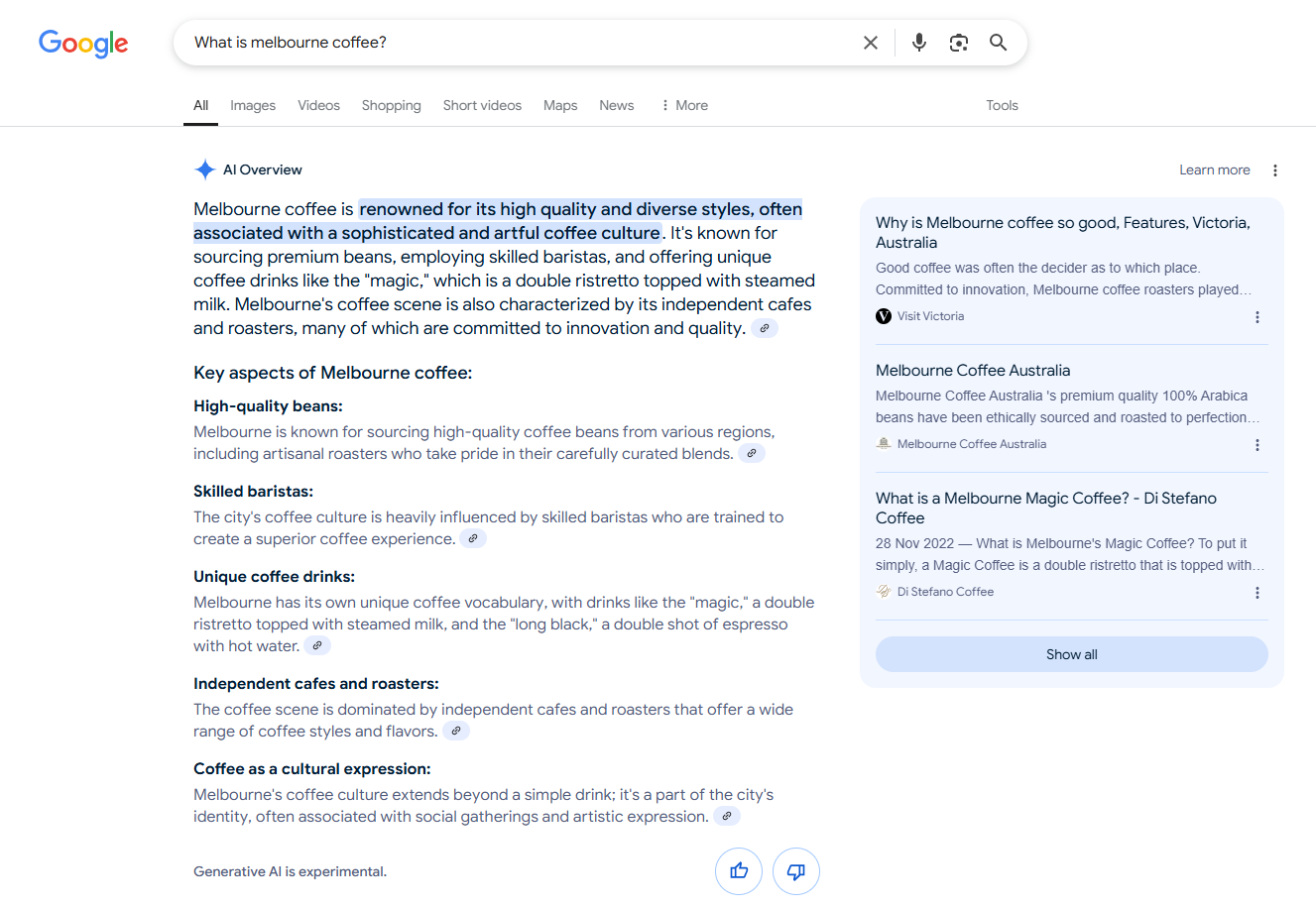
This contextual understanding extends beyond direct mentions. For example, when AI processes content about Melbourne’s coffee scene, it can infer connections to Italian immigration history, even if those links aren’t explicitly written – drawing from its wider knowledge base to enrich its interpretation. This deeper understanding of entities also lays the groundwork for search engines to evaluate the authority and origin of information.
Entity to Authority: The Primary Source Imperative
AI search algorithms now use advanced entity understanding to evaluate authority and origin, demanding a shift in digital strategy. The web is becoming saturated with generic AI-generated content. Search algorithms are evolving to prioritise original insights, research, and analysis. In the AI era, being a primary source – offering first-hand expertise, unique data, or original methodologies – is key to digital authority.
To be recognised as a primary source, businesses must move beyond generic content and produce distinctive, high-value material grounded in their own insights and research. This means transforming industry experience into agenda-setting for content for your niche, that defines your brand and elevates your authority.
Google’s algorithm now rewards content that demonstrates genuine expertise and penalises content created solely to attract search engine visits. This shift is closely tied to Google’s E-E-A-T (Experience, Expertise, Authoritativeness, Trustworthiness) framework, which is increasingly reflected in how AI search engines select and showcase content.
How E-E-A-T Content Drives Authortiy
Google’s E-E-A-T and quality rater guidelines offer a blueprint for content that stands out in both traditional and AI search. The core principle – focus on people-first content, not search engine-first content.
From Google’s guidelines, ask yourself:
- Does this content offer original information, research, or analysis?
- Is it comprehensive, insightful, and genuinely valuable compared to other pages?
- Does it demonstrate clear expertise, with transparent sourcing and author credentials?
- Would users trust, bookmark, or share this page as a definitive resource?
By consistently meeting these criteria – especially through original research and unique perspectives – businesses build true authority. This makes their content far more likely to be recognised, cited, and featured by AI search algorithms.
Entity Hubs & Content Tributaries
Content Authority Hubs built around a core entity – such as a key topic, theme, or concept – are far more effective at signalling topical authority than isolated pages. The central pillar page acts as the hub, offering a broad overview of the entity. Surrounding tributary pages explore specific subtopics and long-tail queries, each naturally linking back to the hub to create a cohesive, interconnected content ecosystem.
Just as Google AI connects key aspects of ‘Melbourne coffee’ – from high-quality beans and skilled baristas to unique drinks and cultural expression –your content ecosystem should map the entities and relationships central to your domain.
Consider a Melbourne-based renewable energy consultancy seeking to position itself as a leader in sustainable energy. By structuring its content around the entity of Sustainable Energy within the context of Victoria’s economy, the firm can establish semantic authority across multiple dimensions.
At the heart of this strategy is a pillar page: ‘Sustainable Energy Solutions in Victoria.’ This serves as a comprehensive resource covering government policy, market trends, technology innovation, and key sustainability initiatives shaping the state.
Supporting this hub are tributary pages such as:
- ‘Advancements in Victorian Solar Technology‘ – exploring efficiency breakthroughs and local manufacturing.
- ‘Case Studies in Wind Farm Development‘ – profiling successful projects and their impact.
- ‘Government Incentives for Renewable Energy‘ – outlining available grants, rebates, and tax support.
- ‘Battery Storage Solutions for Victorian Homes‘ – examining practical applications in residential energy systems.
Each tributary deepens topical coverage while reinforcing the central authority of the hub page. Interlinking these pages not only improves user experience but signals semantic depth and entity association to AI search systems.
This approach positions the consultancy as an authority across key entities: sustainable energy and the Victorian economy. High-quality, locally relevant content will earn citations and mentions, solidifying its entity status. This dramatically enhances the consultancy’s presence in AI-generated search outputs and knowledge graphs.
How AI Constructs Meaning & Attributes Authority to Content
AI-powered search has evolved from simple pattern-matching to language comprehension, mirroring how people communicate and interpret meaning. Unlike traditional search engines that scanned for keywords, modern AI understands context, nuance, and the relationships between concepts.
This shift aligns search more closely with natural human communication. For Australian businesses, the implications are significant. Take a Sydney financial advisor publishing content about ‘investment vehicles.’ Traditional search engines might confuse this with transportation. But AI, using contextual understanding, recognises the financial meaning – ensuring the content reaches the right audience.
AI processes language through multiple layers of analysis:
- Syntax (grammatical structure)
- Semantics (meaning)
- Entities (people, places, things, concepts)
- Relationships (how entities connect)
The result is a search ecosystem that is increasingly being able to detect not just what words say, but their emotional tone, such as sarcasm, hostility or joy, as well as potential bias. And whether statements represent facts or opinions, and a host of other linguistic nuances.
Evolving Trust Signals: From Backlinks to Citation Networks
Historically, backlinks functioned as simple ‘votes,’ with SEO strategies prioritising volume over quality. In the AI-driven search era, however, backlinks have evolved into nuanced trust signals. Modern AI systems now assess backlinks based on contextual relevance, source authority, and their proximity to trusted ‘seed sites.’
A 2024 study of generative AI systems from the University of British Columbia revealed these systems rely heavily on authoritative sources – such as news outlets, media organisations, and reputable business publications – to establish content credibility, even exhibiting sentiment biases depending on query topics.
Beyond individual backlinks, AI evaluates entire citation networks: the patterns and frequency with which authoritative sources reference each other within a topical ecosystem. If research from an Australian health organisation is consistently cited by respected medical journals, government departments, or influential industry experts, AI recognises this interconnected citation pattern as a form of robust social proof, clearly signalling credibility and authoritative status.
How AI Search Ranks Authority: Citation Networks vs. Traditional Backlinks
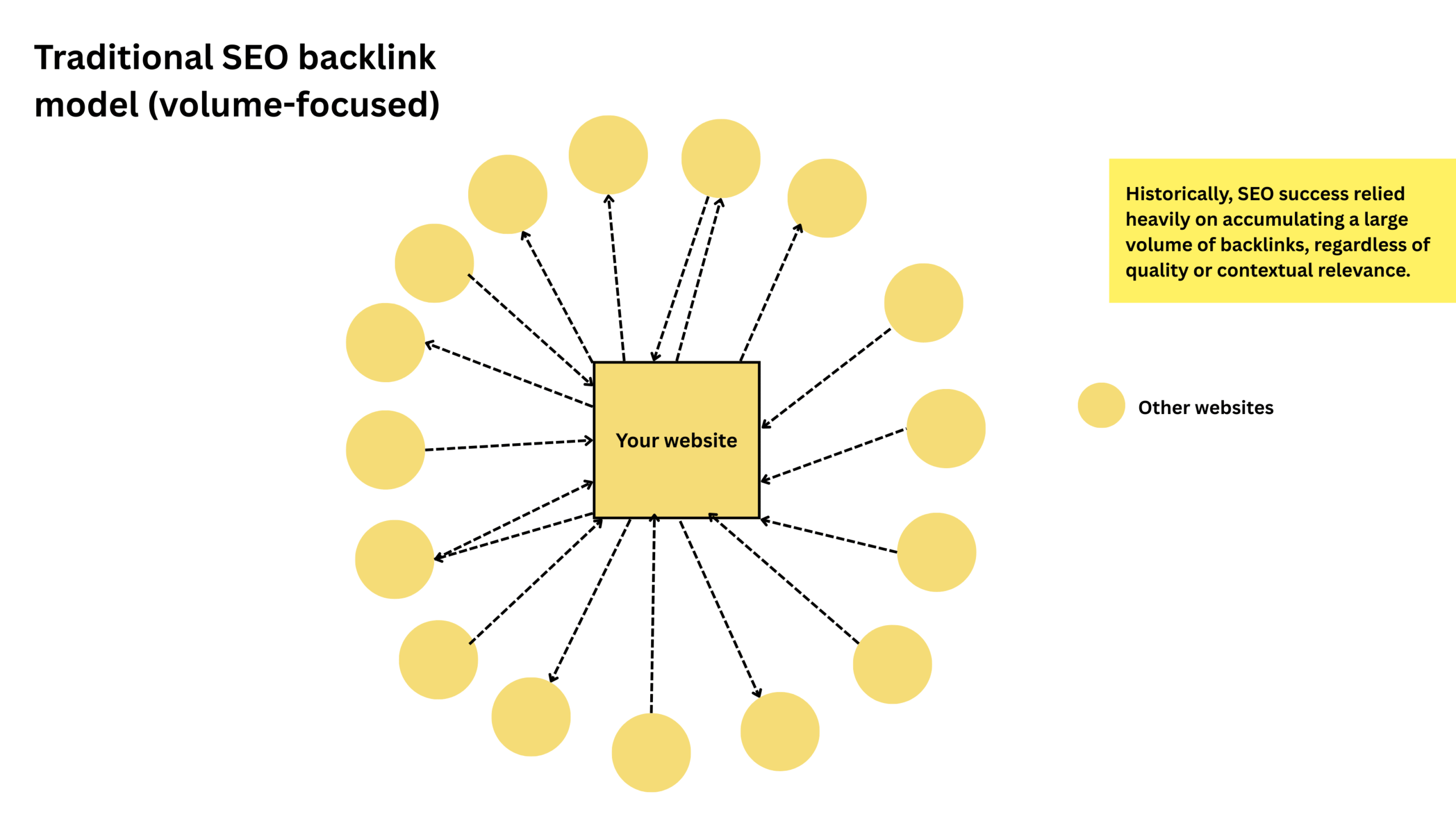
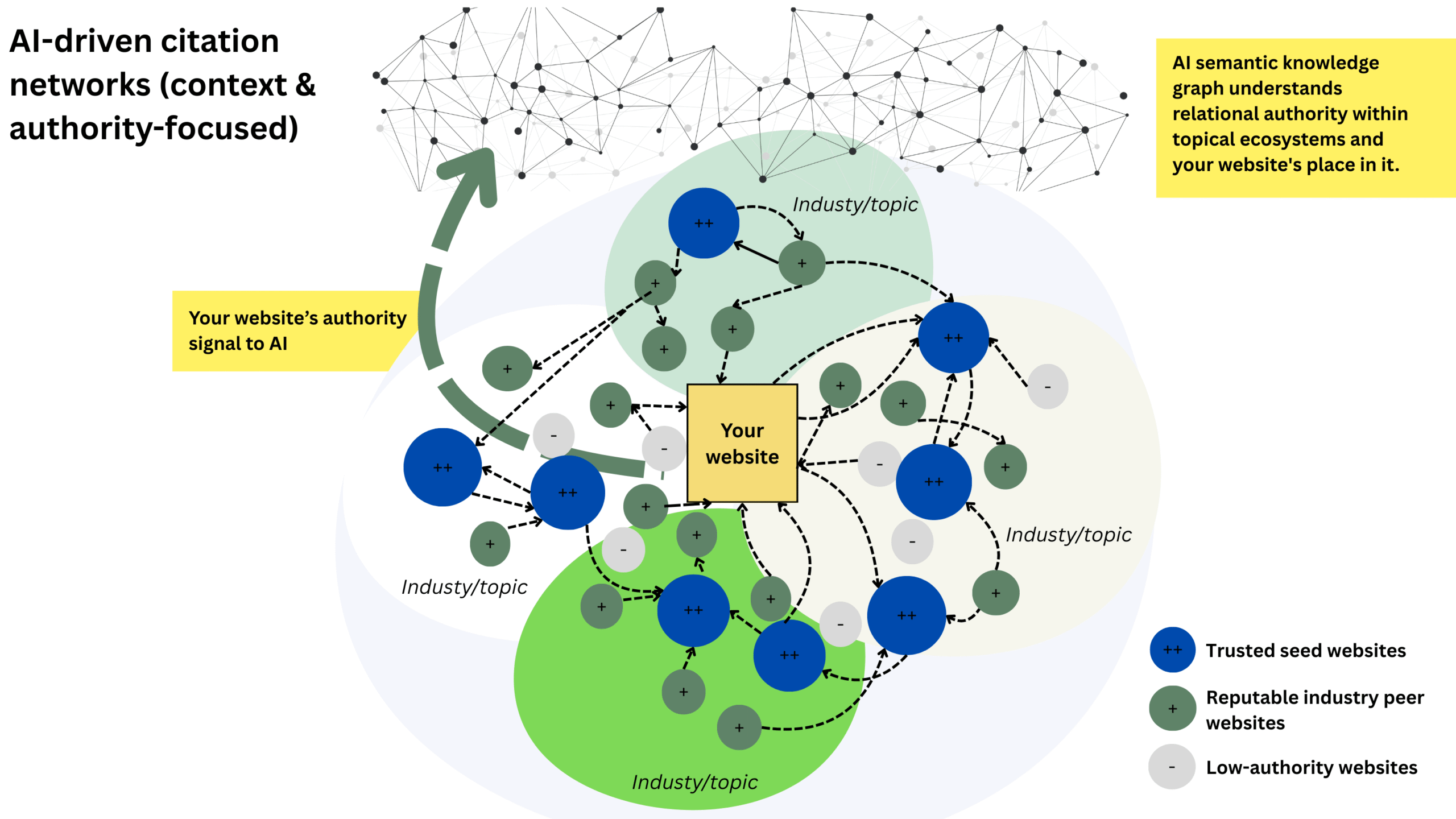
These citation networks underpin Knowledge-Based Trust (KBT) frameworks, where AI verifies factual accuracy by cross-referencing claims across multiple trusted knowledge bases. Backlinks and citations no longer influence just isolated page rankings – they act as semantic signals that validate your content’s authority across a network of trusted knowledge sources.
How AI Analyses Page Hierarchy & Content Structure
AI search platforms interpret how headings, sections, and paragraphs work together to create meaning. This structural awareness helps AI determine which content is most relevant and how information should be prioritised in response to user queries.
For early moving businesses, this presents a major competitive advantage.
A Victorian manufacturing firm that implements a robust content hierarchy not only organises its technical documentation into clear sections but also creates a semantic structure that AI can interpret. For instance:
- The main product page (H1) provides an overview.
- Under this, subsections (H2) cover ‘Technical Specifications,’ ‘Troubleshooting,’ and ‘Maintenance.’
- Within ‘Technical Specifications’ (H3), further breakdowns might include ‘Dimensions,’ ‘Power Requirements,’ and ‘Operating Conditions.’
- Each of these could have additional subheadings (H4) for more granular details.
This hierarchical structure enables AI to understand the relationships between different pieces of information. For example, AI can recognise that ‘Power Requirements’ is a subset of ‘Technical Specifications’ for a particular product, allowing it to provide more precise answers to user queries.
The impact on search results is significant:
- For a query like ‘widget X power requirements,’ AI can directly navigate to the relevant subsection rather than returning the entire technical document.
- If a user asks about troubleshooting a specific issue, AI can prioritise information from the ‘Troubleshooting’ section while still understanding its context within the overall product documentation.
This approach not only improves search accuracy but also enhances the user experience by delivering more targeted, relevant information.
The impact is evident across Google’s AI-powered features, from featured snippets and AI Overviews to the new, more advanced AI Mode. However, the same principles apply across various AI-driven platforms, including ChatGPT, Google’s Gemini, Perplexity, and Claude. These systems all benefit from well-structured content, using it to provide more accurate and contextually relevant responses to user queries.
Speaking Directly to AI via Structured Data: Schema Code
At a more technical level, AI also understands and utilises schema markup and structured data to interpret web content more effectively. Schema markup is a form of structured data that helps search engines and AI systems understand the content of your website
By embedding schema code in your site’s HTML, you provide additional context about your content, such as what a page is about, who or what is featured on the page, and the type of data the page contains (e.g., products, events, reviews).
This structured data serves as a foundation for many AI-driven applications, improving content discovery and enhancing search engine results. For instance, AI-powered platforms like Perplexity, Claude, ChatGPT, and Google’s Gemini rely on schema markup to interpret and rank information.
These systems prioritise content with clear structured data, as it allows them to extract relevant answers faster and with greater accuracy. Schema markup also helps define relationships between different pieces of data on your website, enabling AI tools to accurately convey details such as product attributes, user reviews, or FAQs to users
By implementing relevant schema types – like Product, FAQ, and How-To – and regularly testing your markup, you can significantly improve your site’s visibility in AI-driven search results, voice searches, and rich snippets. Before deploying changes, use tools like Google’s Rich Results Test or Schema Markup Validator to check your schema implementation and ensure it’s error-free.
This not only enhances current visibility but also provides long-term benefits for SEO and AI-driven search, ensuring your site remains visible and relevant as AI technology progresses
Schema Example for a Web Article
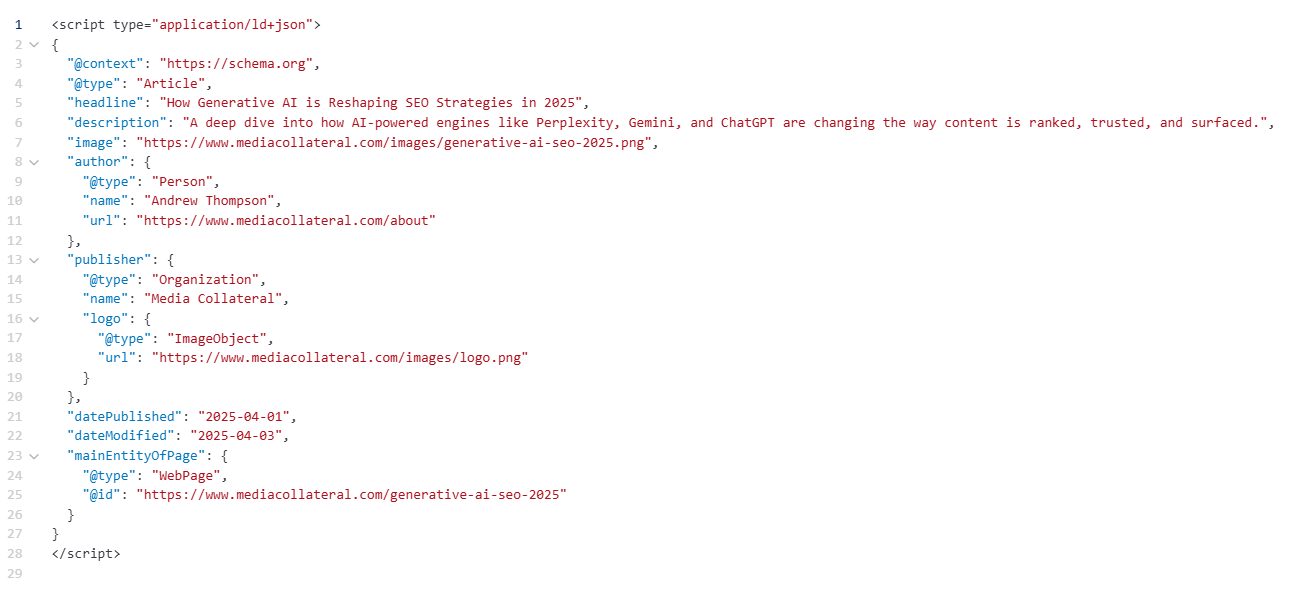
Key Schema Components Explained
| Element | What It Does |
| @context | Declares you’re using Schema.org vocabulary. Essential for all JSON-LD. |
| @type: Article | Specifies this is an article. Search engines treat it differently than, say, a product or FAQ. |
| headline | The article’s title. Appears in search results and influences relevance. |
| description | A short summary of the article. Useful for featured snippets and AI tools. |
| image | Image representing the article. Used in social previews and rich results. |
| author | Who wrote it. Includes name and optional URL to your bio/about page. |
| publisher | Who published it. Adds credibility and brand identity. Includes logo. |
| datePublished | When the article first went live. Important for freshness signals. |
| dateModified | When it was last updated. Helps AI know it’s current. |
| mainEntityOfPage | Canonical URL — tells search engines this is the primary page for the content. |
Multimodal AI Content Understanding: Beyond Text Analysis
AI search comprehension has advanced beyond text analysis to integrate multimodal understanding across text, images, and video. This capability enables AI to extract meaning from multiple content formats simultaneously, resulting in a richer and more comprehensive interpretation of the subject matter.
For instance, consider an e-commerce retailer selling jewellery. A product page for a sterling silver ring can leverage multimodal AI by combining detailed written descriptions with high-quality images and videos. The written content might describe the ring’s features – such as ‘925 sterling silver,’ ‘adjustable size,’ and ‘natural gemstone’ – while the accompanying images showcase its intricate design and the video demonstrates how it looks when worn.
When this multimedia content is properly tagged with schema markup (e.g., Product, ImageObject, or VideoObject), AI search engines can connect these elements to form a holistic understanding of the product. For example:
- A customer searching for ‘adjustable sterling silver ring with turquoise stone’ might see a rich snippet that combines the product description with an image of the ring.
- If they upload an image of a similar ring, multimodal AI can match it with the retailer’s product by recognising visual similarities in design and colour.
This holistic understanding also underpins the visually rich product answers now appearing directly in Google’s new AI Mode. By optimising for multimodal AI, businesses can deliver more engaging, relevant results that align with customer intent, ultimately driving higher conversions and customer satisfaction.
Zero-Click Search: Replacing Clicks & Redefining Visibility
As AI search engines perfect their understanding of content across multiple formats, they now deliver self-contained, synthesised answers directly within the search interface, making a click-through to a website unnecessary for a growing majority of queries.
Google’s AI Mode exemplifies this shift – presenting users with fully-formed answers, multimedia elements, and suggested actions all within the search results page.
Research from SparkToro has demonstrated the rise of zero-click answers, with more than 55% of searches in the U.S. and Europe now resolved directly within search results.
Zero-Click Explained: How AI Engines Bypass the Website
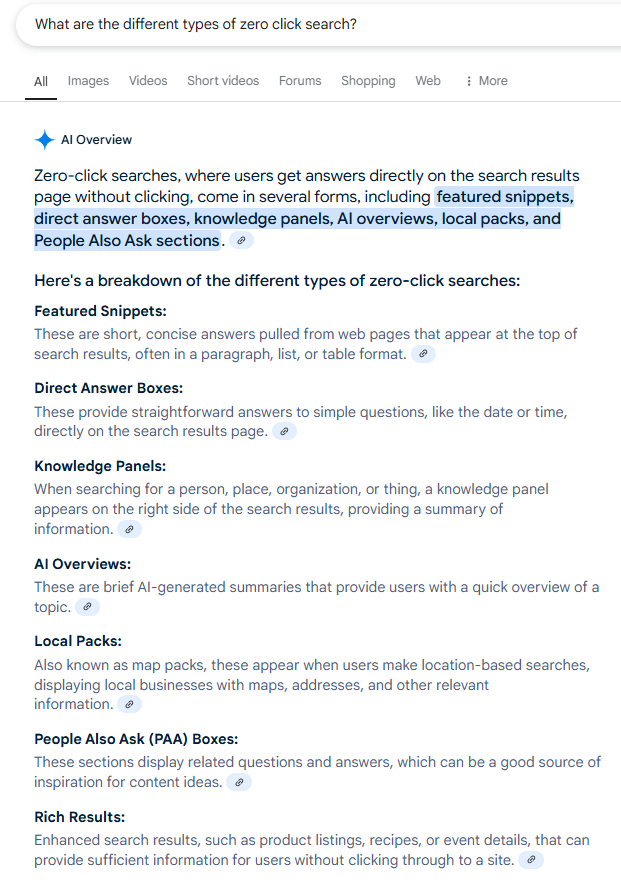
Why Traditional SEO Metrics Lose Meaning in Zero-Click Search
This shift has profound implications for website traffic patterns. Businesses relying heavily on definitional content, simple how-to guides, and straightforward factual information have experienced notable declines in organic traffic.
Unlike featured snippets – which typically credited and linked prominently to source websites – many generative AI platforms synthesise information without clear attribution, further reducing click-through opportunities. Even when sources are cited, the self-contained nature of the AI response often satisfies the user’s immediate need, eliminating their incentive to click through.
Traditional metrics such as click-through rates (CTR) and organic traffic volumes become less meaningful when search engines function as information destinations rather than gateways.
Content previously optimised for ‘position zero’ now faces the paradox of perfect optimisation potentially leading to minimal traffic, as AI extracts and delivers information directly.
How Zero-Click Impacts Organic Traffic & Content ROI
As traditional performance signals decline, new models of value and measurement are emerging.
With traditional analytics capturing only a fraction of actual brand presence in AI-generated results, businesses must recalibrate their measurement frameworks.
Metrics such as impressions, brand recall, and branded search gain greater importance over raw click-through rates.
The visibility provided by appearing consistently in generative AI responses can significantly enhance overall brand recognition, indirectly driving more purposeful branded searches – queries specifically including your company or product name.
This shift from generic query traffic toward branded searches represents a strategic opportunity – users encountering your brand repeatedly within AI-generated answers become more likely to conduct direct branded searches. These queries often indicate stronger intent and convert at higher rates than generic informational searches.
Rethinking Brand Visibility: From Clicks to Impressions and Branded Search
While zero-click answers effectively resolve simple informational queries, research shows that users still prefer clicking through to authoritative websites for more complex, personal, or in-depth topics.
This creates a new visibility dynamic: one where being present in AI outputs is essential for awareness, while rich on-site content is still crucial for conversion and trust-building.
Generative Engine Optimisation (GEO): Redefining Search Strategy
As search technology evolves, a new approach to optimisation has emerged specifically designed for AI-powered platforms. Generative Engine Optimisation (GEO) was originally termed in a paper by academics from Princeton (GEO) and it has since evolved quickly to cover the broader discipline of search optimisation tailored for AI search engines like ChatGPT, Claude, Gemini, and Perplexity.
The principles of GEO are purpose-built for the new capabilities of AI search. When systems like Google’s AI Mode perform ‘Deep Search’ by launching hundreds of queries on a user’s behalf, they are actively looking for the depth, authority, and structural clarity that GEO strategies create.
Unlike traditional SEO, which focuses on keywords and backlinks to rank in conventional search results, GEO aligns content with the sophisticated capabilities of generative AI systems. This fundamental shift moves optimisation from static algorithms to engaging with AI’s fluid understanding of content quality, relevance, and user intent.
GEO in Action: Moving Up in AI Answers
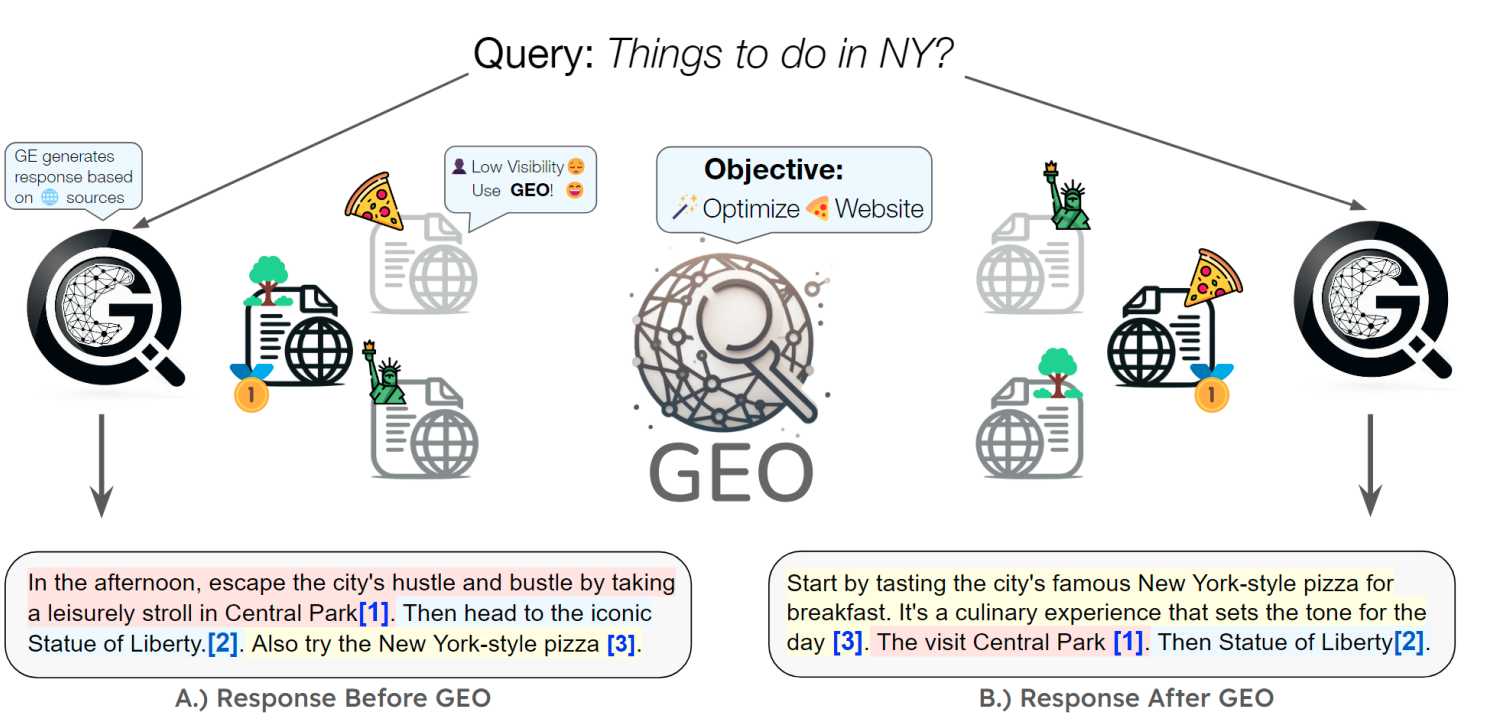
The primary goal of GEO is improving the likelihood of being sourced or included in AI-generated responses, thereby increasing brand visibility and website traffic through citation links. This transition represents a significant paradigm shift in digital marketing strategy, requiring new approaches to content creation and optimisation.
GEO principles emphasise content depth, topical authority, structural clarity, and factual accuracy over traditional ranking signals. By understanding how generative engines evaluate and select sources, businesses can strategically position their content for maximum visibility in AI-generated responses.
We have already touched on the core strategic shifts required for effective GEO:
- Moving from keyword density to comprehensive topic coverage
- Shifting from backlink quantity to content quality validation
- Focusing on entity establishment rather than page-level optimisation
- Prioritising semantic structure over keyword placement
- Building knowledge ecosystems rather than isolated pages
Dual-Intelligence Architecture (DIA): Bridging Machine Logic & Human Engagement
While GEO sets the overarching discipline for optimising visibility in AI-powered search, actually achieving this in practice requires a new kind of website and content architecture, built to distinguish and serve two distinct intelligences – AI systems and human users.
Dual-Intelligence Architecture (DIA) is Media Collateral’s proprietary framework for building websites and content ecosystems that excel in the AI search era. DIA is purpose-built to anchor semantic authority for machines while delivering seamless, engaging experiences for people.
At its core, DIA operates through a tiered model:
- Machine-First Authority: Deep, structured content (like pillar pages), knowledge graph links, and schema markup that establish your expertise and make it easy for AI to parse, trust, and cite your content.
- The Intersect: Shared Foundations: Elements like structured navigation and speed/crawlability that serve both AI and human needs, holding your digital ecosystem together.
- Human-First Engagement: Tributary blogs, conversion architecture, and intuitive navigation designed to convert AI-qualified visitors into real-world outcomes.
These layers create a virtuous cycle: machine comprehension fuels human outcomes, and human engagement validates AI authority.
Dual intelligence Architecture (DIA): engagement & Authority flow
Want to see how DIA works in practice? Explore our full guide to Dual-Intelligence Architecture (DIA).
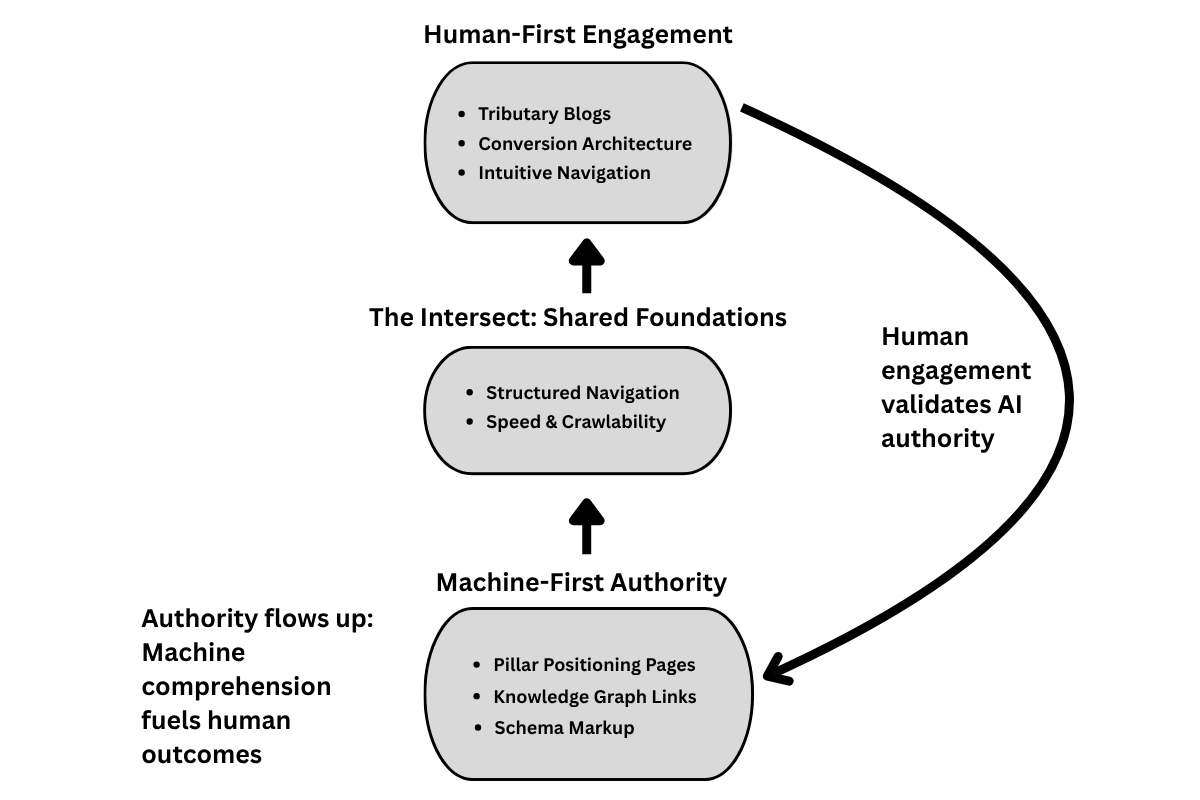
Navigating the AI Search Revolution: Your Path Forward
The AI search revolution is fundamentally transforming how businesses connect with their audiences. As we’ve explored throughout this first guide in the series traditional SEO approaches focused on keywords and backlinks are rapidly giving way to more sophisticated strategies aligned with AI’s advanced comprehension capabilities.
For Australian businesses, this shift creates both challenges and opportunities. Those clinging to outdated tactics will see diminishing returns as AI search becomes the dominant interface between brands and audiences. Conversely, organisations that embrace AI-optimised approaches will gain greater visibility in this new landscape.
In our upcoming guides, we’ll build on these foundations with actionable strategies:
- Mastering Generative Engine Optimisation (GEO) – We’ll explore specific techniques that position your content for maximum visibility in AI-generated answers, moving beyond traditional SEO to embrace the unique requirements of generative systems.
- Building Content AI Trusts – You’ll discover how to establish genuine authority through E-E-A-T principles, creating content that demonstrates expertise, experience, authoritativeness and trustworthiness.
- Earning Citations Through Digital PR – We’ll reveal strategies for positioning your content as a primary source that AI systems consistently reference, building citation networks that enhance your visibility.
- AI-First Website Design – Our final guide will cover the technical strategies that optimise your site for AI comprehension, ensuring your content is structured to maximise understanding and visibility.
The businesses that embrace these strategies now will become trusted sources before the competitive landscape fully shifts. In a rapidly evolving search environment, first-mover advantage will secure authority and visibility that slower-moving competitors will find increasingly challenging to overcome.